Nutritive value for ruminants of two herbaceous South American native legumes: Adesmia bicolor and Adesmia macrostachya
D. G. Vileta A , M. Grosso B and M. Fondevila C DA Departamento de Nutrición Animal, Universidad Nacional de Río Cuarto, Ruta 36, km 601 Río Cuarto, Argentina.
B Departamento de Morfología Vegetal, Universidad Nacional de Río Cuarto, Ruta 36, km 601 Río Cuarto, Argentina.
C Instituto Universitario de Investigación en Ciencias Ambientales, Departamento de Producción Animal y Ciencia de los Alimentos, Universidad de Zaragoza, Miguel Servet 177, 50013 Zaragoza, Spain.
D Corresponding author. Email: mfonde@unizar.es
Animal Production Science 54(2) 158-164 https://doi.org/10.1071/AN12371
Submitted: 2 May 2012 Accepted: 5 February 2013 Published: 23 April 2013
Abstract
Chemical composition, in vitro fermentation and in situ degradability of the native South American legumes Adesmia bicolor and A. macrostachya were studied at vegetative (VG), flowering (FW) and seeding (SD) stages, and compared with those of alfalfa at 10% flowering (AL) in two separate studies. In A. bicolor, crude protein (CP) content was highest for FW, and FW and SD showed higher values than did AL (P < 0.05). At all stages, A. bicolor showed a lower content of neutral detergent fibre and acid detergent fibre than did AL (P < 0.05). The maximum gas production (Coefficient b) was highest for FW, and no differences were recorded between SD and AL, the lowest value being for VG (P < 0.05). The effective dry matter degradability was higher for FW and VG than for SD and AL (P < 0.05), whereas effective CP degradability tended (P = 0.077) to be higher for FW than for the other stages of A. bicolor, but no differences between FW and AL were detected. A. macrostachya had lower CP content (P < 0.001), but its VG and FW stages also had lower proportions of neutral detergent fibre, acid detergent fibre and acid detergent lignin (P < 0.01) than did AL. Chemical and fermentation parameters were affected by maturity of A. macrostachya. The effective dry matter degradability was higher for VG and FW than for SD and AL (P < 0.001), but no differences were apparent on the effective CP degradability. A. bicolor showed a high nutritive value, which was even higher than that of AL, and the maturity stage of this species did not markedly affect its nutritive value, whereas the nutritive value of A. macrostachya reduced as it matured.
Additional keywords: gas production, rumen fermentation.
Introduction
Natural pastures in South American temperate regions have been dramatically degraded because of overgrazing practices (Muir et al. 2008). Furthermore, unfavourable environmental conditions (low temperatures, extended drought periods and low N content in soils) in arid and semiarid regions during winter contribute to restricted feed availability. Re-introduction and establishment of native herbaceous legumes in degraded and unexploited zones is a valid alternative method for soil recovery and for preventing wind erosion, in addition to providing good quality forage for ruminants, mainly to help overcome the scarcity during the winter season (Dias et al. 2004; Kamalak 2006). It has been observed that some species from the South American native genus Adesmia (family Fabaceae, subfamily Papilionoideae) can survive and grow in hard climatic conditions, even during long periods of drought and freezing temperatures, at the time they are grazed by wild and domestic ruminants. This supports their potential value as forage sources during winter (Dall-Agnol and Gomes 1994; Coelho 1996). In a similar way, several native warm-temperate herbaceous legumes have been described in north-central Texas (USA) that can survive freezing temperatures during winter, with minor decreases to their nutritive value (Muir et al. 2011).
Adesmia bicolor is a decumbent, stoloniferous, perennial legume with potential to grow fast (Dodd and Orr 1995), that has been reported in southern Brazil, Uruguay, central Chile and north-eastern Argentina, at altitudes ranging from 550 to 1700 m asl (Veneciano et al. 2005). A. macrostachya, mostly found in northern and central Argentina, is a 50-cm-high, erectile and biannual plant that flowers from late spring to autumn. Because of the high capacity for fixing N (Vileta et al. 2010), the adaptation to hard environmental conditions and the acceptance as feedstuff by grazing cattle (Weberling et al. 2002) of these species have been reported, the nutritive value of A. bicolor and A. macrostachya as forage for ruminants was studied, in terms of chemical composition, in vitro fermentation and in situ degradability, as a preliminary step for in vivo large-scale feeding studies.
Materials and methods
The care and management of the animals agreed with the EU Directive 86/609 on the protection of animals used for experimental and other scientific purposes.
Seeds of A. bicolor and A. macrostachya were collected from wild plants around the location of Villa Rumipal (Córdoba, Argentina), germinated in a greenhouse and the germinants for each species were planted and grown in three 2 m by 2 m plots at the Experimental Campus of the Universidad Nacional de Río Cuarto (Río Cuarto, Córdoba, Argentina; 33°05′S, 64°20′W), 2 years before the start of the study. During this time, weed growth was manually prevented, and no fertilisation was carried out. The soil in this area is a typical Hapludol, with loessic materials and sand texture. The horizon sequence is Ap, Ad, Bw, BC, C and Ck. Throughout the study of A. bicolor (July to November 2008), minimum and maximum monthly temperatures ranged from 2°C to 15°C and from 17°C to 32°C, respectively, and total rainfall was 42 mm. For this species, the experimental period started by an initial cutting (5-cm height) on 15 July. Samples were taken on 29 August (vegetative stage, VG), 6 October (50% flowering stage, FW) and 6 November (100% seeding stage, SD). Nutritive value of A. macrostachya was studied from September to December 2010, with minimum and maximum monthly temperatures ranging from 3°C to 17°C and from 19°C to 31°, respectively, and total rainfall being 241 mm. Sampling dates for this species were 7 October (VG), 11 November (FW) and 2 December (SD). For sampling, a 0.5 m by 0.5 m square was randomly thrown three times on each plot and the vegetal mass included (up to 200 g) was harvested at 5-cm height and pooled, resulting in three samples for each phenological stage of each species. Besides, three samples of alfalfa (Medicago sativa, cv. Trifecta; AL) from the same Campus were harvested in each experimental period at 10% flowering stage, according to the same protocol, and used for the control. Plant samples were dried at 55°C for 48 h, DM content was determined and the dried samples were then ground with a Wiley mill (Thomas Scientific, Swedesboro, NJ, USA) to 2 mm for in situ incubation and to 1 mm for chemical analyses and gas production trial.
The effect of the stage of growth of A. bicolor and A. macrostachya on the fermentation pattern was studied in vitro by the gas production technique (Theodorou et al. 1994). Glass flasks of 100-mL total volume were filled with ~700 mg of air-dry sample and 70 mL of an incubation solution containing 7.0 mL rumen inoculum, and the flasks were then incubated in a water bath at 39°C. An adult, rumen-cannulated steer given alfalfa hay as the only feed was used as the donor of rumen content, which was obtained immediately before the morning feeding, and filtrated through a double cheese cloth. Three runs of incubation were carried out, each one with a different sample of each vegetal substrate. Samples were incubated in triplicate, and the average of the three bottles per treatment was considered as the experimental unit. In addition, three bottles without substrate were also included in each incubation run as blanks. Gas production was measured as pressure changes inside the bottles at 2, 4, 6, 8, 12, 24, 30, 36, 48, 72 and 96 h with an XPlorer GLX manometer (Passport Chemistry Sensor PS2170, PASCO, Roseville, CA, USA). Readings were converted to volume by using a pre-established linear regression between pressure recorded in the same type of bottles and known inoculated air volumes. Once the blank was discounted, the gas volume for each incubation time was expressed per unit of incubated DM. Gas production results from each substrate in each incubation run were fitted to the following equation adapted from McDonald (1981):

where Y is the gas produced at Time t (mL/g DM), b is the maximum gas production (mL/g DM), c is the fractional fermentation rate (h–1), t is incubation time (h) and t0 is the lag time (h). In all cases, fitting of data to the curves gave correlation coefficients (R) of >0.96.
The same rumen-cannulated steer as above was used for in situ incubation procedures. Duplicated samples (~2.5 g) were weighed into 10 × 15 cm nylon bags (ANKOM, Fairport, NY, USA) with a 50 × 20 µm pore size, which then were closed with elastic rubber bands, placed in a 30 × 25 cm plastic mesh with a 250-g ballast and introduced into the rumen immediately before the morning feed. Bags were incubated for 6, 12, 24, 48, 72 and 96 h in three different incubation runs, each one with a different sample of each vegetal substrate, and the average of two bags per treatment was considered as the experimental unit. Once extracted, bags were individually rinsed and washed in cold water in a semi-automated washing machine (3 cycles of 10 min), and then dried at 60°C for 48 h, for determination of DM disappearance. Crude protein (CP, total N × 6.25) was analysed from the incubation residues to estimate CP disappearance. Disappearance results from each substrate and incubation run were fitted to the equation (Ørskov and McDonald 1979)

where Y is degradability at Time t (g/g), a is the soluble fraction (mg/g), b is the insoluble but potentially degradable fraction (mg/g), c is the fractional degradation rate (h–1) and t is incubation time (h). In all cases, fitting of data to the curves gave correlation coefficients (R) of >0.95. Effective degradability of DM or CP (EDDM or EDCP; mg/g) was estimated as

considering a rumen fractional outflow rate (k) of 0.06 h–1.
Chemical composition of feeds was determined according to the procedures described by AOAC (2000) for DM (Reference 930.15), ash (Reference 942.05) and Kjeldahl N (Reference 984.13). Neutral detergent fibre (NDF), acid detergent fibre (ADF) and acid detergent lignin (ADL) were determined following Van Soest et al. (1991). The NDF and ADF are expressed exclusive of residual ash and α-amylase was not used. The ND did not contain sodium sulfite. Plant samples were also analysed for their total phenolic and total tannin contents, following the colorimetric method of Makkar et al. (1993) using the Folin–Ciocalteau reagent, and with tannic acid (MERCK Chemicals, Madrid, Spain) as the reference standard. Total tannins were estimated as the difference in total phenolics between and after treatment with polyvinyl polypyrrolidone. All samples were analysed in duplicate.
Results for each Adesmia species were compared with those for alfalfa within each experimental period with one way ANOVA using INFOSTAT 2005/P.1 (Universidad de Córdoba, Argentina). For the chemical analyses and in vitro and in situ incubations, the three samples of each phenological stage of A. bicolor, A. macrostachya and those of alfalfa were considered as the experimental units and compared statistically (Udén et al. 2012). Differences among means with P < 0.05 and 0.05 < P < 0.10 were accepted as representing statistically significant differences, and tendencies to differences, respectively.
Results
Nutritive value of A. bicolor
Average DM content of A. bicolor when harvested at VG, FW and SD stages was 338 ± 41.1, 339 ± 58.5 and 350 ± 29.4 g/kg, respectively, whereas that of AL was 177 ± 8.2 g/kg. The chemical composition of A. bicolor at VG, FW and SD stages, compared with AL, is shown in Table 1. The highest and lowest proportions of CP were observed at FW and VG, respectively (P < 0.05), whereas both FW and SD recorded higher values than did AL. In addition, FW showed the lowest proportion of NDF and ADF (P < 0.05), and all stages of A. bicolor showed lower values for both cell-wall parameters than did AL. The content of total phenolics and total tannins in A. bicolor samples was below 22 mg tannic acid equivalents/mg DM, and that of total tannins was negligible (data not compared statistically).
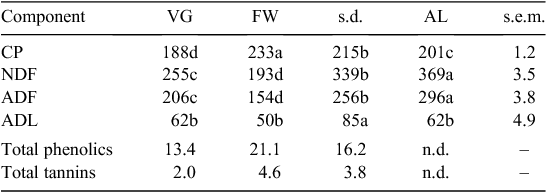
|
The pattern of in vitro gas production and the coefficients of the fitted equations are shown in Fig. 1 and Table 2, respectively. Among substrates, AL showed the highest gas volume after 2- and 4-h incubation (P < 0.01), but no differences were recorded among AL, FW and SD up to 24 h. After 4 h, gas production at FW became highest, whereas no differences in gas production were recoded between AL and SD. Throughout the whole incubation period, the volume of gas produced from VG was lower than that from FW and AL, and it was also lower than that from SD at 4 h and from 72 to 96 h (P < 0.05). Coefficient b was highest (P < 0.05) for FW, and lowest for VG, recording intermediate values for SD and AL. Coefficient c was higher for AL than for FW and SD, and among phenological stages, it diminished as A. bicolor matured (P < 0.05). Higher lag time t0 was recorded with VG and FW than with AL and SD (P = 0.001).
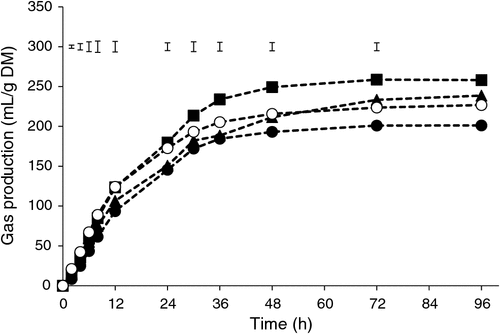
|

|
Among adjusted coefficients of the pattern of in situ DM and CP disappearance (Table 3), the Coefficient a differed among treatments (P < 0.001), being highest for VG and recording higher values for FW than for AL. In contrast, Coefficient b was highest (P < 0.05) for FW. Consequently, the sum of a+b, which indicates the maximum DM disappearance, was highest for FW and VG, intermediate for SD and lowest for AL (P = 0.002), whereas Coefficient c was lowest (P < 0.05) for SD. The EDDM estimated from degradation coefficients reached higher (P < 0.05) values for FW and VG than for SD and AL.
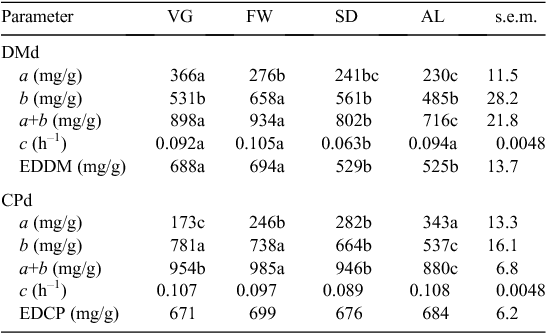
|
For CP degradability (Table 3), the Coefficient a was highest, and b lowest (P < 0.05), for AL, whereas the opposite occurred for VG, with FW and SD recording intermediate values. Maximum CP disappearance (a+b) ranked as follows: FW > VG > SD > AL (P < 0.001). There was a trend (P = 0.077) for a lower CP fractional degradation rate c for SD than for VG and AL. The EDCP tended (P = 0.077) to be higher for FW than for SD and VG, with AL recording intermediate values.
Nutritive value of A. macrostachya
The CP content of A. macrostachya diminished as the plant matured (P < 0.001), being lower at the three phenological stages of the plant than for AL (Table 4). The NDF content was highest (P < 0.001) for SD. Similarly, proportions of ADF (P < 0.001) and ADL (P = 0.011) were also highest for SD, but no differences were recorded between SD and AL. For all cell-wall components (NDF, ADF and ADL), VG and FW stages of A. macrostachya showed lower values than did both SD and AL. As for A. bicolor, total phenolic and total tannin contents of A. macrostachya were low to exert any biological effect, irrespective of the phenological stage of the plant.
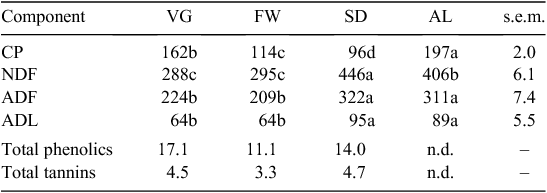
|
There were no differences among treatments in the gas production pattern after 4 and 6 h of incubation (Fig. 2). Thereafter, gas production for AL became higher than that for FW, which was higher than that for SD throughout the incubation period (P < 0.01), whereas differences between AL and VG were significant only at 8 h (P = 0.012). No significant differences were detected between VG and FW, but SD showed the lowest volumes of gas fermentation. Coefficient b of the fitted equations from the gas production pattern was lower for FW than for AL (P = 0.003), recording intermediate values for VG (Table 5). The lowest Coefficients b and c were recorded for SD (P < 0.05), and no treatment differences were observed at t0 (P > 0.10).
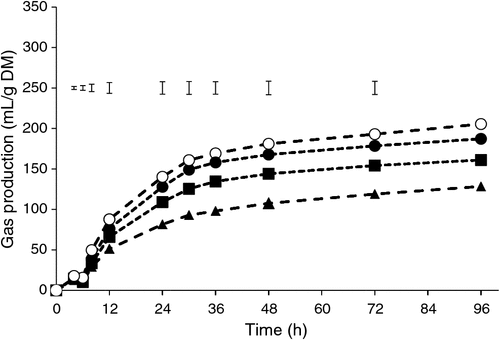
|

|
The response in the Coefficients a and b of DM degradation showed an inverse ranking among treatments (Table 6). Thus, Coefficient a was highest for SD and lowest for AL, showing intermediate values for VG (P < 0.001), whereas maximum and minimum values of Coefficient b were reached for VG and SD, respectively (P < 0.001). When considering a+b, VG was the highest, followed by FW, and the lowest values were found for AL and SD (P < 0.001). Differences in the fractional degradation rate c were detected only between FW and SD (P = 0.044). Estimated EDDM was higher for VG and FW than for SD and AL (P < 0.001). Coefficients from the fitted equation for CP degradation behaved similarly, and a+b ranked as follows: VG > FW > AL > SD (P < 0.001). However, no differences were manifested in Coefficient c or EDCP (P > 0.10).
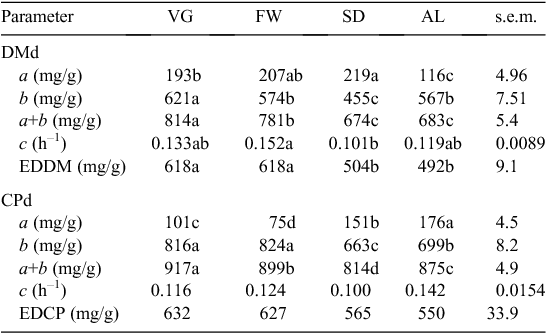
|
Discussion
Very scarce information is available concerning growth requirements, productive yield or nutritive value of the South American native legumes A. bicolor and A. macrostachya. Hence, the present work can be considered as a preliminary study on the potential use of these Adesmia spp. as feed for ruminants. As a reference, DM yields estimated from harvesting A. bicolor and A. macrostachya were 1762 ± 58 and 6487 ± 112 kg DM/ha, respectively. These data must be considered with caution because they were obtained from 2 m by 2 m experimental plots; however, they can be considered as an indication of the productive potential of each species. Results of composition and rumen utilisation of the two Adesmia spp. cannot be directly compared because they were tested in different periods; however, both were contrasted with alfalfa as a positive control, as has also been done by others (Foster et al. 2007).
Other Adesmia species, such as A. punctata, A. latifolia, A. tristis and A. aconcaguensis, have also been studied, showing CP contents ranging from 172 to 234 g/kg (Dall-Agnol and Gomes 1994) or from 102 to 145 g/kg (Coelho 1996). The presence of anti-nutritional factors has been described in some Adesmia species, although the toxicity of this genus is considered low (Agnese et al. 1998). Concretely, the proportions of both total phenolics and total tannins in A. bicolor and A. macrostachya can be considered as innocuous for rumen fermentation and intestinal metabolism of ruminants.
It is worth noting that the protein content of A. bicolor at its FW and SD stages was more than 30 and 10 mg/g higher, respectively, than that of AL grown in the same environmental conditions, whereas NDF and ADF contents of A. bicolor were lower regardless of the phenological stage. In contrast, CP content of A. macrostachya was 35–101 mg/g lower than that for AL, but proportions of cell-wall components were higher for alfalfa than they were in the VG and FW stages of A. macrostachya. These results, together with the negligible content of secondary compounds such as phenolics and tannins in these native legumes, support their potential as feed resources for South American ruminants at pasture. In both Adesmia species, CP decreased, and the proportion of cell-wall components increased, as the plant matured, but at a lower extent in A. bicolor than in A. macrostachya. Even though it is expected that the protein content of forages diminishes with their stage of maturity (Buxton 1996; Yu et al. 2004), unlike cell-wall content, the proportion of CP was highest and NDF and ADF were lowest in A. bicolor at its FW stage, whereas VG showed the opposite values. Such a reduction in the proportion of the fibrous component as the plant matures should be explained by the low proportion of the cell-wall component in decumbent stems, being lignified at a lower extent as has also been reported for other stoloniferous legumes, such as white clover (Buxton 1996; Drewhurst et al. 2009). This is in contrast with what was observed for A. macrostachya, because it is an erectile plant, with the proportion of stems being 0.33 ± 0.008 at the VG (D. G. Vileta and M. Grosso, unpubl. data). In this type of plants, the proportion of the stem component increases with maturity, at the time when the cell-walls lignify (Ulyatt 1981; Buxton 1996), thus reducing their nutritive value.
The result of gas production indicated that the FW stage of A. bicolor as a substrate was as fermentable as was AL. After 24 h of incubation, no differences were detected between A. bicolor and AL in gas volume, as an indicator of the extent of fermentation, except for VG. Further, maximum gas production (Coefficient b) was higher for FW than for AL, and did not differ between SD and AL. Estimation of gas production at a time corresponding to a transit rate of 0.06 (that is, a residence time in the rumen of 16.7 h, which can be considered as typical of a forage diet) would give 152, 146, 123 and 120 mL/g DM for FW, AL, SD and VG, respectively. The faster fermentation rate of AL in the first 24 h of incubation, which was markedly stabilised afterwards (Fig. 1), can be explained by the high content of solubles and ADF in AL (Table 1). There was no major effect of the phenological stage of A. bicolor on its fermentative potential. As has been noted above, the high and relatively constant proportion of leaves in this stoloniferous species helps maintain the nutritive value of the plant as it matures (Ulyatt 1981; Drewhurst et al. 2009).
A moderate effect of maturity has also been observed in other Adesmia species; in vitro organic matter digestibility from the vegetative stage to the start of flowering in A. punctata and A. latifolia, ranged from 0.72 to 0.68 and from 0.71 to 0.72, respectively (Scheffer-Basso et al. 2001). Minor variations in in vitro digestibility with phenological stage of legumes have been reported for other legumes (Marinas et al. 1993; Terrill et al. 2003), although this response is not consistent, and the opposite has also been observed in vitro and in situ with white clover (Ayres et al. 1998) and alfalfa (Buxton 1996; Yu et al. 2004). In this way, the extent and rate of gas production from in vitro fermentation of A. macrostachya were reduced as the plant matured and, except for its vegetative stage, the gas production was lower than that from alfalfa. This is in agreement with what was discussed above regarding the changes in chemical composition of this species with age, confirming that increasing maturity of A. macrostachya would be manifested in a reduction in fermentability.
Results for in situ disappearance must be considered with caution, because dried plant leaves are very fragile, and can be reduced to a very small-size particles when ground in the laboratory. This might artificially increase the soluble fraction (Mota et al. 2005; Foster et al. 2007), an effect that would be more important for FW and VG because of their lower NDF contents (Table 1). In fact, DM losses during washing for non-incubated bags were 383, 296, 258 and 237 mg/g for VG, FW and SD stages of A. bicolor and AL, respectively. In this way, whereas the EDDM of FW, which was more than 30 percentage units higher than that of AL, agrees with results from in vitro gas production, the high EDDM in VG might be a consequence of its high water solubility after grinding. In any case, values recorded here for A. bicolor are similar to those reported by Drewhurst et al. (2009) for white clover, another stoloniferous temperate legume. However, washing losses of DM for phenological stages of A. macrostachya were higher (380, 415 and 429 mg/g for VG, FW and SD), and in situ DM results agreed with those of in vitro gas production, probably because substrate differences were larger than they were for A. bicolor.
In situ CP degradability of A. bicolor behaved similarly to DM degradability, and EDCP tended (P = 0.077) to be higher for FW than for SD and VG, but no differences were manifested between alfalfa and A. bicolor at any vegetative stage. In the same way, EDCP at any phenological stage of A. macrostachya did not differ from that of AL.
Conclusions
Adesmia bicolor showed a high nutritive value, which was even higher than that of AL, either in terms of chemical composition (protein and cell-wall contents) or fermentation and degradation pattern, especially at the FW stage, although other factors should also be taken into account. Besides, the maturity does not markedly affect the nutritive value of this species. In contrast, CP content of A. macrostachya was lower than that of alfalfa, and diminished with maturity at the time when the proportion of cell-wall components increased. However, fermentation pattern at the VG stage did not differ from that of alfalfa. These results, together with the observed resistance of these species to adverse climatic conditions and their role in soil stability, have highlighted the potential of these legume species for use in livestock production systems in arid and semiarid regions of South America.
References
Agnese AM, Juliani HR, Cabrera JL (1998) Chemotaxonomic features of lipophilic components in Adesmia species (Leguminosae). Plant Systematics and Evolution 210, 141–145.| Chemotaxonomic features of lipophilic components in Adesmia species (Leguminosae).Crossref | GoogleScholarGoogle Scholar | 1:CAS:528:DyaK1cXit12mtr8%3D&md5=ca7c6e4b9bc7453e54a903cdbcebabfbCAS |
AOAC (2000) ‘Official methods of analysis.’ 17th edn. (Association of Official Analytical Chemists: Arlington, VA)
Ayres JF, Nandra KS, Turner AD (1998) A study of the nutritive value of white clover (Trifolium repens L.) in relation to different stages of phenological maturity in the primary growth phase in spring. Grass and Forage Science 53, 250–259.
| A study of the nutritive value of white clover (Trifolium repens L.) in relation to different stages of phenological maturity in the primary growth phase in spring.Crossref | GoogleScholarGoogle Scholar | 1:CAS:528:DyaK1MXhtFSqtrg%3D&md5=d57ed77e067f2c434db24bd1ded56614CAS |
Buxton DR (1996) Quality-related characteristics of forage as influenced by plant environment and agronomic factors. Animal Feed Science and Technology 59, 37–49.
| Quality-related characteristics of forage as influenced by plant environment and agronomic factors.Crossref | GoogleScholarGoogle Scholar |
Coelho LGM (1996) Citogenética e qualidade da forragem de espécies de Adesmia DC nativas no Brasil. MSc Thesis, Universidade Federal de Santa María, Brazil.
Dall-Agnol M, Gomes KE (1994) Qualidade de forragem de accesos de género Adesmia. In ‘Proceedings of the 31ª reuniao da Sociedade Brasileira de Zootecnia’. p. 456. (Anais da SBZ: Maringá, Brazil)
Dias PMB, Dall’Agnol M, Schiffino-Whittmann MT (2004) Genetic diversity in the Brazilian species of Adesmia DC. (Leguminosae) as assessed by RAPD. Plant Genetic Resources 2, 43–50.
| Genetic diversity in the Brazilian species of Adesmia DC. (Leguminosae) as assessed by RAPD.Crossref | GoogleScholarGoogle Scholar | 1:CAS:528:DC%2BD2MXis1SlsLw%3D&md5=c7a9e926bff3282a6124d303a53aa121CAS |
Dodd MB, Orr SJ (1995) Seasonal growth, phosphate response and drought tolerance of 11 perennial legume species grown in a hill-country soil. New Zealand Journal of Agricultural Research 38, 7–20.
| Seasonal growth, phosphate response and drought tolerance of 11 perennial legume species grown in a hill-country soil.Crossref | GoogleScholarGoogle Scholar |
Drewhurst RJ, Delaby L, Moloney A, Boland T, Lewis E (2009) Nutritive value of forage legumes used for grazing and silage. Irish Journal of Agricultural and Food Research 48, 167–187.
Foster JL, Muir JP, Lambert BD, Pawelek D (2007) In situ and in vitro degradation of native Texas warm-season legumes and alfalfa in goats and steers fed a sorghum-sudan basal diet. Animal Feed Science and Technology 133, 228–239.
| In situ and in vitro degradation of native Texas warm-season legumes and alfalfa in goats and steers fed a sorghum-sudan basal diet.Crossref | GoogleScholarGoogle Scholar | 1:CAS:528:DC%2BD2sXnslyitQ%3D%3D&md5=4264b8f80f85bca4ab269cb557808ffcCAS |
Kamalak A (2006) Determination of nutritive value of leaves of a native grown shrub, Glycyrrhiza glabra L. using in vitro and in situ measurements. Small Ruminant Research 64, 268–278.
| Determination of nutritive value of leaves of a native grown shrub, Glycyrrhiza glabra L. using in vitro and in situ measurements.Crossref | GoogleScholarGoogle Scholar |
Makkar HPS, Blummel M, Borowy NK, Becker K (1993) Gravimetric determination of tannins and their correlations with chemical and protein precipitation methods. Journal of the Science of Food and Agriculture 61, 161–165.
| Gravimetric determination of tannins and their correlations with chemical and protein precipitation methods.Crossref | GoogleScholarGoogle Scholar | 1:CAS:528:DyaK3sXksVCms7o%3D&md5=dedcae178faff0c2084bf2f09214a7ecCAS |
Marinas A, García-González R, Fondevila M (1993) The nutritive value of five pasture species occurring in the summer grazing ranges of the Pyrenees. Animal Science 76, 461–469.
McDonald I (1981) A revised model for the estimation of protein degradability in the rumen. The Journal of Agricultural Science 96, 251–252.
| A revised model for the estimation of protein degradability in the rumen.Crossref | GoogleScholarGoogle Scholar | 1:CAS:528:DyaL3MXktVCjtL0%3D&md5=bbcfe2a4017eb23d4648245e524e8cc9CAS |
Mota M, Rodríguez R, Solanas E, Fondevila M (2005) Evaluation of four tropical browse legumes as nitrogen sources: comparison of in vitro gas production with other methods to determine N degradability. Animal Feed Science and Technology 123–124, 341–350.
| Evaluation of four tropical browse legumes as nitrogen sources: comparison of in vitro gas production with other methods to determine N degradability.Crossref | GoogleScholarGoogle Scholar |
Muir JP, Randall Bow J, Rodríguez W, Patterson JM (2008) Defoliation of panicled tick-clover, tweedy’s tick-clover and tall bush-clover: II. Herbage nutritive value and condensed tannin concentrations. Agronomy Journal 100, 1635–1639.
| Defoliation of panicled tick-clover, tweedy’s tick-clover and tall bush-clover: II. Herbage nutritive value and condensed tannin concentrations.Crossref | GoogleScholarGoogle Scholar |
Muir JP, Pitman WD, Foster JL (2011) Sustainable, low-input, warm season, grass–legume grassland mixtures: mission (nearly) impossible? Grass and Forage Science 66, 301–315.
| Sustainable, low-input, warm season, grass–legume grassland mixtures: mission (nearly) impossible?Crossref | GoogleScholarGoogle Scholar |
Ørskov ER, McDonald I (1979) The estimation of protein degradability in the rumen from incubation measurements weighed according to rate of passage. The Journal of Agricultural Science 92, 499–503.
| The estimation of protein degradability in the rumen from incubation measurements weighed according to rate of passage.Crossref | GoogleScholarGoogle Scholar |
Scheffer-Basso SM, Avila Jacques AV, Dall’Agnoll M, Riboldi J, Castro SMJ (2001) Disponibilidade e valor nutritivo de forragem de leguminosas natives (Adesmia DC.) e exóticas (Lotus L). Revista Brasileira de Zootecnia 30, 975–982.
| Disponibilidade e valor nutritivo de forragem de leguminosas natives (Adesmia DC.) e exóticas (Lotus L).Crossref | GoogleScholarGoogle Scholar |
Terrill TH, Gelaye S, Mahotiere S, Amoah EA, Miller S, Windham WR (2003) Effect of cutting date and frequency on yield and quality of kudzu in the southern United States. Grass and Forage Science 58, 178–183.
| Effect of cutting date and frequency on yield and quality of kudzu in the southern United States.Crossref | GoogleScholarGoogle Scholar |
Theodorou MK, Williams BA, Dhanoa MS, McAllan AB, France J (1994) A simple gas production method using a pressure transducer to determine the fermentation kinetics of ruminant feeds. Animal Feed Science and Technology 48, 185–197.
| A simple gas production method using a pressure transducer to determine the fermentation kinetics of ruminant feeds.Crossref | GoogleScholarGoogle Scholar |
Udén P, Robinson PH, Mateos GG, Blank R (2012) Use of replicates in statistical analyses in papers submitted for publication in Animal Feed Science and Technology. Animal Feed Science and Technology 171, 1–5.
| Use of replicates in statistical analyses in papers submitted for publication in Animal Feed Science and Technology.Crossref | GoogleScholarGoogle Scholar |
Ulyatt MJ (1981) The feeding value of temperate pastures. In ‘Grazing animals. World animal science, series B’. (Ed. FHW Morley), pp. 125–141. (Elsevier: Amsterdam)
Van Soest PJ, Robertson JB, Lewis BA (1991) Methods for dietary fiber, neutral detergent fiber and nonstarch polysaccharides in relation to animal nutrition. Journal of Dairy Science 74, 3583–3597.
| Methods for dietary fiber, neutral detergent fiber and nonstarch polysaccharides in relation to animal nutrition.Crossref | GoogleScholarGoogle Scholar | 1:STN:280:DyaK38%2FnvVCltA%3D%3D&md5=83605a987aed1cab5024d20cbdabf9b5CAS | 1660498PubMed |
Veneciano JH, Frasinelli CA, Kraus TA, Bianco CA (Eds) (2005) ‘Domesticación de especies forrajeras.’ 1st edn. (Universidad Nacional de Río Cuarto Press: Río Cuarto, Argentina)
Vileta DG, Bianco L, Grosso M, Malpassi R (2010) Biological nitrogen fixation by Adesmia bicolor (Poir.) DC. and Adesmia macrostachya, potential forage species for arid and semi-arid environments. Interciencia 35, 120–125.
Weberling F, Kraus T, Bianco CA, Malpassi R (2002) Variación y estrategias adaptativas de los sistemas de ramificación de Fabáceas herbáceas. Feddes Repertorium 113, 342–353.
| Variación y estrategias adaptativas de los sistemas de ramificación de Fabáceas herbáceas.Crossref | GoogleScholarGoogle Scholar |
Yu P, Christensen DA, McKinnon JJ (2004) In situ rumen degradation kinetics of timothy and alfalfa as affected by cultivar and stage of maturity. Canadian Journal of Animal Science 84, 255–263.
| In situ rumen degradation kinetics of timothy and alfalfa as affected by cultivar and stage of maturity.Crossref | GoogleScholarGoogle Scholar |


